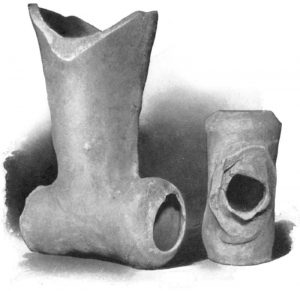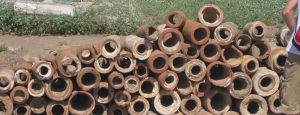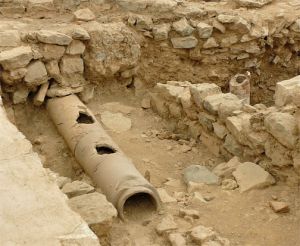


Knee and t-joints made about 4000 B.C. Found in the excavation of the Temple of Bel at Nippur, Babylonia. Pipe was made of baked clay. Babylonia is often referred to as the birthplace of pipe.
Source: Cast Iron Pipe, Standard Specifications Dimensions and Weights (Burlington, New Jersey: United States Cast Iron Pipe & Foundry Co.,1914), p. 13.
A large number of clay water pipes in the ruined city of Ephesus (near modern Selcuk, on the west coast of Turkey). Most pipes are still in the ground. The first buildings in Ephesus were constructed in 2000 BCE, and it grew into a large town by about 1000 BCE. In the richer section of town, houses had cold and hot running water (in winter) and closed sewage disposal to the lower section of town where there were large public toilet facilities (across from the famous library) which were continually flushed with the “grey” water of the houses. That waste did not run into the clay pipes but in covered stone-block canals. (Information provided by Frans Lamers.) Photo date 2005.
Source: Frans Lamers, Cost Rica.
A huge collection of Roman-era clay water supply pipes in a museum in Pafos, Cyprus.
Source: Source: “A historical perspective on the development of urban water systems,” by William James, Professor of Water Resources Engineering, University of Guelph, Guelph, Ontario,Canada.